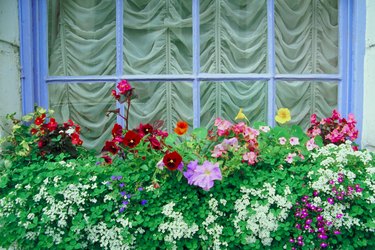
The clusters of tiny, white, four-petaled flowers cover sweet alyssum (Lobularia maritima) during the cool days of spring until early summer and may flower again in fall and winter. A tender perennial, the species plant and its cultivars are often grown as annual flowers outside U.S. Department of Agriculture plant hardiness zones 9 through 11. Alyssums reseed prolifically; deadhead and trim them regularly to refresh the plants and prevent the seeds from scattering and filling the garden with volunteer seedlings.
About Sweet Alyssum
Video of the Day
A member of the Brassicaceae family, also called the mustard or cabbage family, sweet alyssum prefers cool temperatures to produce its prolific flowers. Often planted as an annual low-growing border plant or ground cover, alyssum grows best in full sun and partial shade. While established plants can tolerate dry soils, they grow and flower better when they receive at least 1 to 2 inches of water weekly.
Video of the Day
In addition to the white-flowering alyssums, there are a number of cultivars that produce flowers ranging from pink to apricot to purple and all the shades in between. In some states, particularly along the West Coast, alyssum has escaped gardens and has invaded the coastal dunes, meadows and wetlands. However, some cultivars are sterile, so worries about alyssum's invasiveness become moot when planting 'Snow Princess' or other non-seed-setting varieties.
Taking Safety Precautions
Before digging in the garden bed and when preparing to deadhead or trim your alyssum plants, put on gloves, safety goggles and other protective gear. Also sterilize your cutting tools by dipping the blades in rubbing alcohol or full-strength Lysol or Pine-Sol. While a 10 percent chlorine bleach solution is good for disinfecting plastic, ceramic and terra-cotta containers, avoid using bleach to sterilize metal cutting tools because it will corrode the blades.
Planting Sweet Alyssum
Prepare a sunny or partially shady, well-drained garden bed by digging in 2 to 3 inches of compost as soon as the soil can be worked in spring or in late summer for flowers in mild winter climates. Alyssum prefers a well-drained soil; if the site is heavy clay or boggy, consider installing raised beds or using containers. Water to moisten the soil and then plant seeds by pressing gently onto the soil. Don't cover the seeds; they need light to germinate.
Alternatively, plant the seeds in seed-starting trays or peat or other biodegradable pots five or six weeks before the last frost date in your area. Moisten the potting mix and press the seeds onto the mix. Keep the soil or potting mix evenly moist until the seeds germinate, generally in eight to 14 days when temperatures are between 55 and 70 degrees Fahrenheit.
Keep the seedlings at 50 to 55 degrees at night before planting in the garden. Space the plants 6 to 8 inches apart. Water weekly or biweekly when the weather warms up. The plants grow into flower-covered mounds that spread into a matted covering over the soil.
Pruning Alyssum Back
While alyssum blooms from spring to fall in cooler summer climates, hot temperatures make the plants go dormant. Approximately four weeks after the first flowers appear, use pruning shears and cut the plants back by one-half. If you don't want the plants to reseed, deadhead the flowers as they begin to fade or plant a sterile cultivar. In late summer and fall, the plants bloom again and often continue blooming until frost arrives.
Fertilize lightly with a balanced, slow-release fertilizer and water thoroughly. Alternatively, spread compost amid the plants and water it in to provide a slow infusion of organic nutrients. Potted alyssum requires monthly feedings with a liquid fertilizer applied according to the package directions.